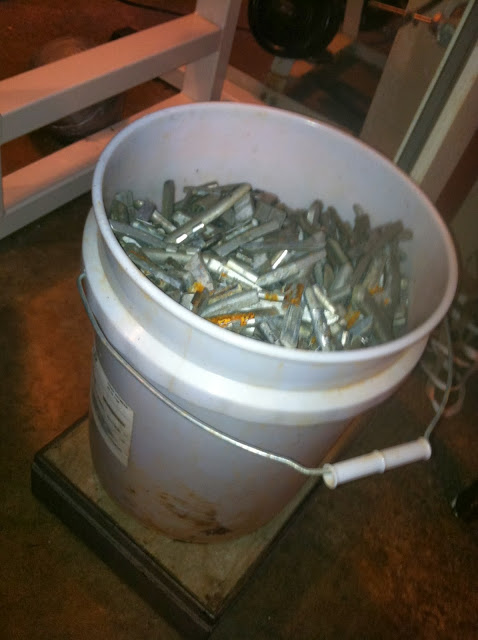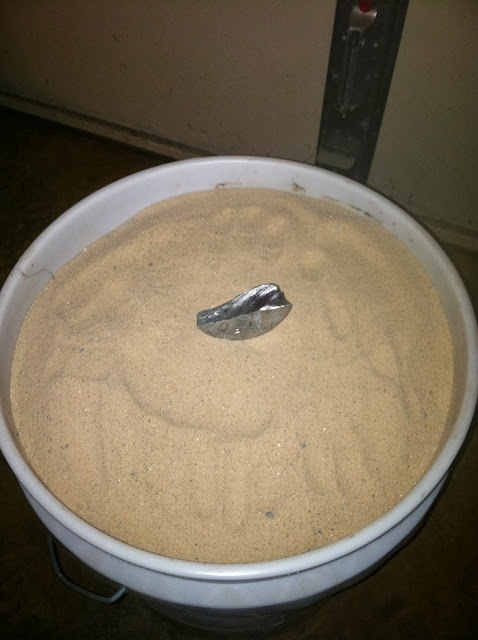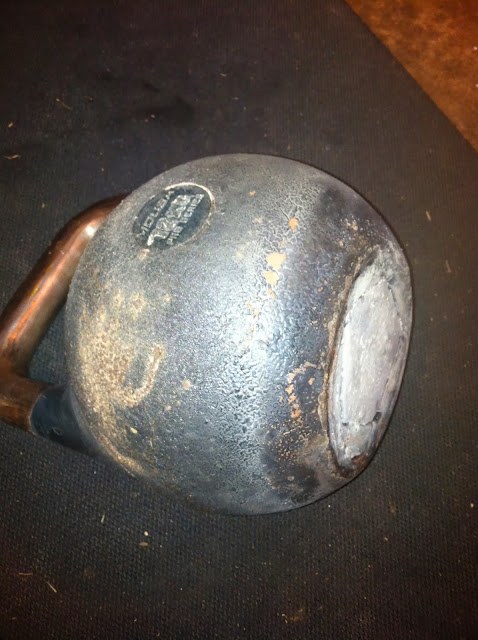I recently undertook a project I've been thinking about for a long time: filling a hollow competition kettlebell with lead to make it very heavy. A 48k prograde bell costs upwards of $200, plus shipping by freight. Call it $300, minimum. That's a lot of clams! In this post, I'll walk through how I made my own, and break down the cost.
First, I cut the kettlebell open with an angle grinder. It was full of granular fiberglass, as you can see in the pictures below. I kept the fiberglass and used it later in the project. This was a 12k kettlebell.
First, I cut the kettlebell open with an angle grinder. It was full of granular fiberglass, as you can see in the pictures below. I kept the fiberglass and used it later in the project. This was a 12k kettlebell.
Inside the empty kettlebell, there was a piece of rebar to help with structural stability. This was perfect, as I wanted one solid piece of lead which would not rattle around in the bell. The rebar gives an additional support for the lead to grab. I started with a 26 pound kettlebell, and ended up with a 16 pound hollow shell.
I started with a bucket of old wheel weights, weighing 128 pounds, total. Most wheel weights are lead, with steel clamps, but some are zinc and some are iron. These can't be used; they are skimmed off and recycled.
I set up a smelting operation to make pure lead ingots. Lead melts at 612 degrees F, so it is a pretty basic operation. Propane stove, pot, slotted spatula, and muffin tin. Gloves and eye protection, of course.
The melted lead sinks to the bottom, and everything else floats. I skimmed it off with the slotted spatula. I put it in a cardboard box, into which I had put the fiberglass from the kettlebell. The fiberglass is good insulation against the very hot metal.
I poured the lead into the muffin tin to make ingots of pure lead. I thought I had more hair than this. Very disconcerting.
The result is a little over 92 pounds of pure, solid lead in muffin-shaped ingots- easy to handle.
At this point, the plan was simple: melt the lead inside the kettlebell. I could not melt and pour the lead, because it would cool too quickly for the new lead to bond, resulting in layers and chunks within the kettlebell. It would work if I could melt and pour it all in one batch, but common sense says trying to manhandle 90 pounds of molten metal is a bad idea. The solution is to pack the kettlebell in a bucket of sand and heat the lead inside it. The sand also keeps the kettlebell from cooling too fast, resulting in lead shrinkage. This idea was not original to me, I got it from watching Adam Glass make his heavy kettlebell here.
Because the melting point of lead is so low, any propane torch will do the job, however, I failed to take one thing into account: the torch quickly burned all the oxygen in the kettlebell, and went out. For this, I would need help, so I went to see my neighbor, Louis, who is a metal fabricator and mechanic with a shop full of toys. Louis set me up with an acetylene torch, which brings its own oxygen. Even so, we had to run an additional oxygen line into the kettlebell to keep the torch lit. Below, you can see the torch, the oxygen line, and the lead inside the kettlebell. Once this arrangement was rigged, melting the lead went quickly, and the kettlebell was filled in just over half an hour. The torch kept it hot enough that it all melted together in one solid piece.
I had just enough lead to fill the kettlebell, with a little left over, seen here.
I took the kettlebell home, and covered it with the rest of the sand. I let it sit overnight.
In the morning (3:30 a.m., actually, because I could not sleep), I took the kettlebell out and dusted it off. The paint is cooked, and some sand has bonded to the bell, so it will need to be sanded and painted. Louis sent me home with half a can of spray-on bedliner to seal the lead.
I weighed the kettlebell: 108.5 pounds. The "beast" kettlebell is 106 lb., or 48k. This is within the margin of error at just over 49k.
The bill: I already had the kettlebell, but it cost $50. I used one bag of sand, which I can reuse for other projects: $3.50. I used one propane cylinder to make the ingots: $2.00. The muffin tin was bought for the project, and thrown out afterward: $6.00. The lead was free. Louis estimated I used maybe $1 worth of acetylene, bringing my bill, start to finish, to $61.50. I already had the kettlebell and the propane, so my out of pocket outlay was only $9.50. That's a far cry from the $300 it would take to have a heavy prograde bell delivered.
I'm sure the finished, painted kettlebell will make its debut in pictures and video soon.
I'm more interested in self-reliant living than I am in kettlebell lifting, and a man has time to think while melting lead, so a few observations came to mind.
First, safety. Is melted lead dangerous? Of course. But I also drive on the interstate, shoot guns, and lift weights. I've caught alligators and stepped into the ring with black belts. Life is dangerous. Common sense mitigates a lot of risks. Living in fear of danger just makes us miss out on a lot of living.
Second, self-reliant people have a network of others they can call on. Without help from Louis, I would not have been able to finish this project. A few months ago, he called me because he had a pickup truck full of heavy stuff to unload, and his back had gone out. I went over and unloaded it for him. We're not great friends, but we both try to be good people, and can be counted on to lend a hand. When hurricane Katrina hit New Orleans, thousands of people were looting and pillaging like pirates, taking what they needed by force from others who were no better off than themselves, waiting for "the system" to help them. When flooding hit Missouri a few months later, entire towns worked together to build sandbag levies to save each other's homes. That's the difference between selfish people and self-reliant people.
Third, cost. I saved a boatload of money doing this myself. I got the kettlebell I wanted for the cost of lunch. Even if I had to buy everything at once, it would have cost 1/5 of the price of a new one. It took most of the day, but saved me $240. I'll work for $30 an hour. Maybe I'll use my savings to join Hair Club for Men.
Finally, pride. We live in a world in which we are detached from the production of our own goods. When I grow a garden or kill a deer to feed my family, I'm proud of it- I did that. When I repair something instead of replacing it, I'm proud of that. My children are 12 and 13, and they don't have self-esteem problems. They also don't sit around playing video games. They create and build, they knit and sew, they write and draw, they are martial artists and powerlifters. They are proud of themselves because they know they have done something worth doing. My wife has created a business of her own, and she is justifiably proud of her product and of the money she makes. It's not arrogance. God created us to be productive, and when we are, it feels right.
Now, the time for philosophical musings has come to an end. The time for swinging a heavy kettlebell has come.












Excellent job and an excellent post about it as well - well done, sir.
ReplyDeleteThanks, Steve!
DeleteNice project! Hope that you enjoy the new bell!
ReplyDeleteThanks! I'm not sure "enjoy" is the right sentiment!
DeleteSteve, great work man! I enjoyed your write-up and the method behind building the Beast is fascinating too. Added you to my blogroll man. Wish I had found your blog years ago. It'll be fun to read through your old posts though.
ReplyDelete-Ben Edwards
Thanks, Ben. It's mostly just my training log, but I hope it's helpful.
Delete